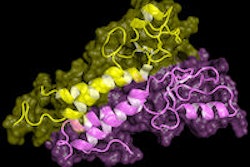
Women carrying a mutation in the BRCA1 or BRCA2 genes who have undergone a mammogram or chest x-ray before the age of 30 are more likely to develop breast cancer than those who carry the gene mutation but who have not been exposed, researchers from Amsterdam have noted in an article published online yesterday by the British Medical Journal (BMJ).
"The results of this study support the recommendation to use nonionizing radiation imaging techniques (such as MRI) as the main tool for surveillance in young BRCA1/2 mutation carriers," stated lead author Dr. Anouk Pijpe, PhD, a postdoctoral research fellow in the department of epidemiology and biostatistics at the Netherlands Cancer Institute. "While previous studies were based only on mammography or radiography, this large cohort study used estimates of an individual age-specific cumulative breast dose from various diagnostic radiation procedures as a measure of total diagnostic radiation exposure."
The authors looked at 1,993 female BRCA1/2 mutation carriers in the Netherlands, France, and the U.K. between 2006 and 2009 to see whether variations in DNA increase the chances of radiation-induced breast cancer risk. Follow-up ended with diagnosis of first breast cancer. All patients were age 18 or older. Women were questioned about exposure via x-ray or mammogram, age at first exposure, number of exposures before the age of 20, at ages 20-29, 30-39, and age at last exposure.
The results showed 43% (848) of the 1,993 women were diagnosed with breast cancer. A total of 48% (926) reported having an x-ray and 33% (637) a mammogram. The average age at first mammogram was 29 years. A history of any exposure to diagnostic or screening radiation to the chest at ages 20-29 increased breast cancer risk by 43% and any exposure before the age of 20 increased breast cancer risk by 62%. No association with breast cancer was apparent for exposures at ages 30-39.
For every 100 BRCA1/2 mutation carriers 30 years old, nine will have developed breast cancer by age 40, and the number of cases would increase by five if all had had one mammogram before age 30. The authors do say however that this estimate "should be interpreted with caution because there were few women with breast cancer who had had a mammogram before age 30 in the study."
The study does have limitations, the authors noted.
"The retrospective nature of our study, however, might have caused recall bias. We relied on self-reports rather than review of medical records because of the difficulties in accessing medical records with regard to the various diagnostic procedures. These took place for many different indications and many occurred in the distant past," they wrote.
Although exposure to diagnostic radiation before the age of 30 was associated with an increased breast cancer risk in BRCA1/2 mutation carriers, they added that due to "puzzling" findings in the differences between breast cancer risk for BRCA1 and BRCA2 carriers, larger studies are needed to determine whether a difference does in fact exist.



















